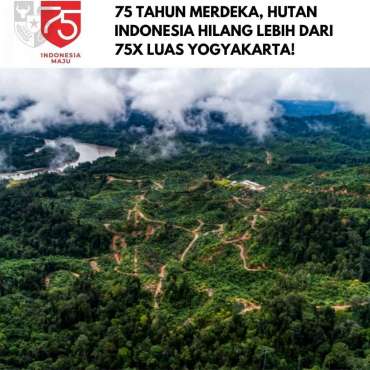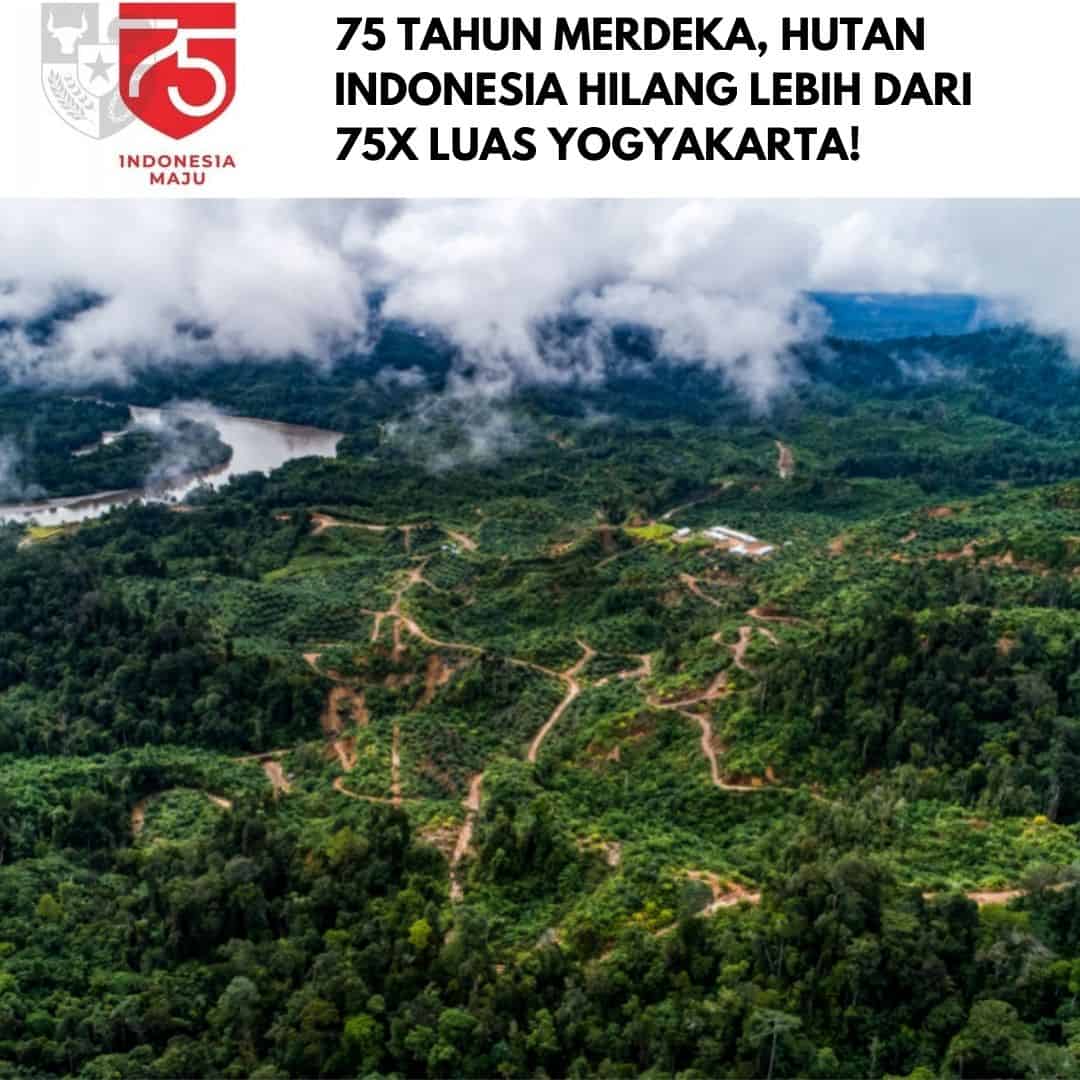 Bogor, 17 Agustus 2020. Selama 75 Tahun Merdeka, Indonesia telah tujuh kali berganti rezim pemerintahan dan telah kehilangan hutan alam lebih dari 23 juta hektare atau setara dengan 75 kali luas Provinsi Yogyakarta. Setidaknya kehilangan hutan seluas itu adalah angka yang tercatat di FWI sejak tahun 2000-2017. Sejak saat itu, kita belum juga mampu menghadirkan tata kelola hutan yang baik. Kondisi hutan alam yang terus berkurang dan terdegradasi merupakan akumulasi dari lemahnya tata kelola hutan yang terjadi dari tahun ke tahun. Pada rentang tahun 2000-2009, Indonesia kehilangan hutan alam seluas 1,4 juta ha/tahun.
Bogor, 17 Agustus 2020. Selama 75 Tahun Merdeka, Indonesia telah tujuh kali berganti rezim pemerintahan dan telah kehilangan hutan alam lebih dari 23 juta hektare atau setara dengan 75 kali luas Provinsi Yogyakarta. Setidaknya kehilangan hutan seluas itu adalah angka yang tercatat di FWI sejak tahun 2000-2017. Sejak saat itu, kita belum juga mampu menghadirkan tata kelola hutan yang baik. Kondisi hutan alam yang terus berkurang dan terdegradasi merupakan akumulasi dari lemahnya tata kelola hutan yang terjadi dari tahun ke tahun. Pada rentang tahun 2000-2009, Indonesia kehilangan hutan alam seluas 1,4 juta ha/tahun.
Pada periode selanjutnya (2009-2013) luasan hutan alam yang hilang berkurang menjadi 1,1 juta ha/tahun dan kembali naik pada periode 2013-2017 menjadi 1,4 juta ha/tahun. Temuan ini tentu menjadi alarm bagi pemerintah khususnya KLHK (Kementerian Lingkungan Hidup dan Kehutanan) untuk lebih serius dalam mencegah kerusakan hutan alam di Indonesia demi menjaga keberlangsungan hajat hidup rakyat Indonesia.
Berdasarkan hasil kajian FWI, pada periode 2013-2017 angka deforestasi hutan alam di indonesia sebesar 5,7 juta hektare dengan 2,8 juta hektare berada dalam konsesi dan 2,9 juta hektare lainnya berada di luar konsesi. Angka deforestasi tersebut seharusnya menjadi trigger untuk mendalami lebih lanjut apa penyebab deforestasi yang terjadi di Indonesia. Apakah akibat aktivitas illegal logging, kinerja konsesi yang belum sejalan dengan upaya pencegahan deforestasi atau memang justru bagian dari deforestasi yang direncanakan.
Angka yang berbeda justru dikeluarkan oleh pemerintah, KLHK menyatakan bahwa deforestasi di Indonesia terus berkurang dari tahun ketahun. Melihat data resmi pemerintah, pada periode tahun yang sama (2013-2017) hutan yang terdeforestasi di Indonesia seluas 2,7 juta hektare. Perbedaan mengenai makna deforestasi disinyalir menjadi salah satu landasan munculnya perbedaan angka yang cukup timpang. “Pendefinisian deforestasi saat ini dapat mengaburkan realitas atas kehilangan hutan alam yang sebenarnya, sehingga perlu dikembalikan motivasinya dalam kerangka penyelamatan hutan alam Indonesia” terang Mufti Barri, Manajer Kampanye FWI.
Beberapa instrumen dalam upaya penurunan laju deforestasi seperti sertifikasi Pengelolaan Hutan Produksi Lestari (PHPL) dan verifikasi legalitas kayu (VLK) juga belum mampu menjawab permasalahan deforestasi di Indonesia. Meski sebagian besar izin konsesi pemanfaatan kayu sudah bersertifikat, tetapi masih menunjukkan adanya deforestasi yang terjadi. Deforestasi terjadi di konsesi IUPHHK-HA (HPH) dan IUPHHK-HT (HTI) yang sudah tersertifikasi sekitar 356 ribu hektare.
Dalam IUP perkebunan kelapa sawit, dengan skema ISPO (Indonesia Sustainable Palm Oil) pun ternyata belum terbebas dari deforestasi. Analisa FWI menunjukan dari 2,3 juta hektare yang sudah bersertifikat ISPO masih terdapat deforestasi sekitar 52 ribu hektare. Deforestasi di konsesi tambang sekitar 700 ribu hektare dan deforestasi di wilayah yang tumpang tindih antara HPH, HTI, kebun dan tambang sekitar 786 ribu hektare. Begitu juga untuk deforestasi di luar konsesi sekitar 2,9 juta hektare, yang bahkan menjadi samar apa penyebabnya.
Sehingga solusi tawaran perlindungan hutan alam oleh pemerintah melalui moratorium hutan dan sawit, penurunan emisi atau perlindungan untuk areal dengan nilai keanekaragaman hayati tinggi, ataupun sistem sertifikasi yang berkelanjutan belum secara optimal menjawab persoalan deforestasi di Indonesia. Terlepas dari efektif atau tidaknya semua kebijakan-kebijakan tersebut. Atau bisa jadi memang solusi tersebut belum bisa menjangkau seluruh penyebab deforestasi.
“Pemerintah perlu untuk mendalami apa saja yang menjadi penyebab langsung atau tidak langsung berikut dengan motif dari pelaku kerusakan, agar bisa dipahami persoalannya dengan benar dan solusi tawarannya menjadi lebih tepat. Identifikasi dan upaya pencegahan deforestasi juga harus didorong hingga level tapak, karena disetiap tapak kompleksitas permasalahannya sangat mungkin berbeda satu sama lainnya dan solusinya pun bisa sangat berbeda.” tutup Mufti F. Barri (Manajer Kampanye FWI).
***
Catatan Editor :
- 2020. Menelisik Angka Deforestasi Pemerintah http://fwi.or.id/menelisik-angka-deforestasi-pemerintah/
- Secara harfiah, deforestasi bisa diartikan sebagai kehilangan hutan. Dalam Undang-undang No 41 tahun 1999 pada pasal satu angka dua, “hutan adalah suatu kesatuan ekosistem berupa hamparan lahan berisi sumber daya alam hayati yang didominasi pepohonan dalam persekutuan alam lingkungannya, yang satu dengan lainnya tidak dapat dipisahkan.” Dengan demikian, mendefinisikan hutan seyogyanya tidak hanya mengartikannya hanya sebagai sekumpulan pepohonan, tetapi juga peran dan fungsinya sebagai salah satu penentu sistem penyangga kehidupan dan bahkan juga menjadi ruang hidup bagi seluruh makhluk hidup tidak terkecuali manusia.
- Definisi yang digunakan oleh pemerintah Indonesia saat ini merujuk pada Peraturan Menteri Lingkungan Hidup dan Kehutanan nomor 70 tahun 2017 tentang tata cara pelaksanaan reducing emissions from deforestation and forest degradation, role of conservation, sustainable management of forest and enhancement of forest carbon stocks. Dalam aturan tersebut, deforestasi didefinisikan sebagai perubahan secara permanen dari areal berhutan menjadi tidak berhutan yang kemudian dibagi menjadi Deforestasi Gross dan Deforestasi Nett.
- Deforestasi Gross adalah perubahan secara permanen tutupan hutan alam tanpa memperhitungkan pertumbuhan kembali (regrowth) dan atau pembuatan hutan tanaman. Deforestasi Nett adalah perubahan secara permanen tutupan hutan, dengan memperhitungkan pertumbuhan kembali (regrowth) dan/atau pembuatan hutan tanaman. Dan didefinisikan juga mengenai degradasi hutan sebagai penurunan kuantitas tutupan hutan dan stok karbon selama periode tertentu.
- Definisi deforestasi yang digunakan oleh pemerintah lebih ditujukan sebagai landasan informasi dalam kebijakan terkait dengan isu perubahan iklim. Mekanisme penghitungan karbon yang diimplementasikan dalam pendefinisian hutan dan perubahannya secara langsung telah mereduksi definisi yang ada di Undang-Undang Kehutanan. Indikasinya, bahwa data deforestasi yang secara agregat menunjukkan penurunan, tetapi perspektif lain atas data yang sama menunjukkan bahwa deforestasi hutan alam di Indonesia malah menunjukkan peningkatan.
- Laju deforestasi hutan Indonesia pada periode tahun 1985-1998 tidak kurang dari 1,6 – 1,8 juta hektar per tahun (Dephutbun, 2000). Pada tahun 2000, laju deforestasi meningkat menjadi paling tidak 2 juta hektar per tahun (FWI/GFW, 2001). Menurut KLHK, Selama Orde Reformasi sampai saat ini deforestasi semakin menurun, pada tahun 2016-2017 berada di angka 0,48 juta hektare.
- Data resmi menunjukkan bahwa pada periode 2013-2014 deforestasi turun ke angka 0,4 juta hektar per tahun setelah pada periode sebelumnya berada pada angka 0,73 juta hektar per tahun. Angka deforestasi kemudian naik pada periode 2014-2015 menjadi 1,09 juta hektar per tahun lalu turun menjadi 0,63 juta hektar per tahun pada periode 2015-2016 dan turun kembali ke angka 0,48 juta hektar per tahun pada periode 2016-2017.
- Hasil Analisis FWI menunjukkan deforestasi pada periode 2013-2017 diperkirakan mencapai angka kurang lebih 5,7 juta hektare atau sekitar 1,46 juta hektar per tahun. Angka ini mengalami peningkatan dari rerata deforestasi dibandingkan dengan periode tahun 2009-2013 yaitu 1,1 juta hektar per tahun.
- Dalam periode 2013-2017 terdapat 169 sertifikat Pengelolaan Hutan Produksi Lestari (PHPL) IUPHHK-HA & HT, perusahaan yang memiliki nilai baik sebanyak 133, yang memiliki nilai Sedang sebanyak 35 perusahaan dan yang memiliki nilai buruk sebanyak 4 perusahaan bernilai buruk.
- Deforestasi di IUPHHK HA, HT, IUP Sawit dan Konsesi Pertambangan.
| Luas Deforestasi di dalam Konsesi (dalam hektar) | |||||||
| Pulau | Tumpang Tindih antar Konsesi | HPH | HTI | IUP Tambang | IUP Sawit | Total | Deforestasi Luar Konsesi |
| Sumatera | 27.524 | 45.537 | 127.823 | 74.714 | 65.402 | 341.000 | 631.906 |
| Jawa | – | – | – | 4.120 | – | 4.120 | 125.920 |
| Bali Nusra | 7.034 | 3.153 | 8.592 | 33.179 | 47 | 52.005 | 332.005 |
| Kalimantan | 611.060 | 196.657 | 124.700 | 176.798 | 313.661 | 1.422.876 | 629.144 |
| Sulawesi | 58.025 | 21.167 | 34.365 | 289.692 | 10.362 | 413.611 | 535.527 |
| Maluku | 51.814 | 99.913 | 5.066 | 89.545 | 10.062 | 256.400 | 287.166 |
| Papua | 31.783 | 34.075 | 28.191 | 39.398 | 186.997 | 320.444 | 371.663 |
| Total | 787.240 | 400.502 | 328.737 | 707.446 | 586.531 | 2.810.456 | 2.913.331 |
| Total Deforestasi | 5.723.787 |
Kontak Untuk Wawancara :
Mufti Fathul Barri | Manager Kampanye FWI | muftiode@fwi.or.id | +62821-1067-7935




